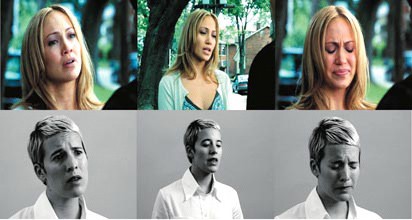
Candice Breitz, Becoming Jennifer, 2003 © Candice Breitz
The 1st at Moderna: Candice Breitz
Become
1.10 2004 – 12.12 2004
Stockholm
Born in Johannesburg, South Africa, she has had first-hand experience of the violent language barriers typical of colonialism and apartheid. Her experience in complex language environments has had great significance for her art practice.
BECOMING is, in brief, a work about the language and identity of Western woman, as she is represented for us through Hollywood’s romantic lens. The apparent simplicity of the work is, as always in Breitz’s case, deceptive: complex questions and political issues boil just beneath the surface.
Breitz made BECOMING in Stockholm, during a residency at IASPIS over the summer of 2003. The process began with the rental of dozens of films, all of which starred a famous actress whose character is formed by her romantic involvement with a male counterpart. Eventually, Breitz selected seven sequences from as many films, to form the basis of BECOMING. The chosen films are significant only in that they share a certain status in the world of global culture. Each has been widely distributed and viewed by millions of people all over the world and is thus exemplary of the shared cultural consumption that we increasingly experience. The viral spread of global culture exerts an ominous influence not only on our behaviour and daily attitudes, but also on our ideals.
Breitz isolates less than a minute of footage for each of the actresses represented in BECOMING: Cameron Diaz, Julia Roberts, Jennifer Lopez, Meg Ryan, Neve Campbell, Reese Witherspoon and Drew Barrymore. In each of the short sequences chosen, an actress gives vent to a range of emotions: sorrow, joy, anger or desperation. The manipulated sequence (the leading men have, for example, been edited out) is presented in colour on a monitor that is then set back-to-back with a second monitor on which we view, in black and white, the same sequence now re-enacted by Breitz. The original and the copy are bound together like Siamese twins, not only by their back-to-back presentation, but also because they share the same voice: the original Hollywood soundtrack underlies both the source clip and the Breitz version, making the two inseparable. With no acting experience at all, Breitz set out to mimic the actresses’ performances as earnestly as possible. Dressed in a plain white blouse and black trousers, the artist stands out starkly against the bare backdrop that she chose for the shoot. The installation alludes at once to the profound and difficult process of identity formation, as it does to the hit MTV series BECOMING, from which it takes its title.
BECOMING marks the first time that Breitz has used herself in her work. Her decision to cast herself as blank screen, to subject herself head-on to the influences of mass culture, produces thought-provoking results. The artist does not locate herself on the outside of the culture that she dismantles (as a removed observer), but rather surfs the wave of media influences that washes over us, from within its core. Though the viewer encounters both the Hollywood actress and Breitz face-to-face on their monitors, the monitors are mounted such that they can never be viewed simultaneously. Comparison of the pair is only possible through a circling of the two monitors; a circling that impels us to reflect actively on the complex workings of the installation. Breitz is interested in re-activating the act of viewing. She refers to Jean-Luc Godard’s statement, “In films, you have to give, but first of all you have to receive. Audiences no longer give because with television you stop giving. There’s only the receiving end.”
Curator: Catrin Lundqvist
The 1st at Moderna is an exhibition programme for contemporary art. The opening is always on the first day of the month, and the exhibitions are in different venues in or outside the museum.
